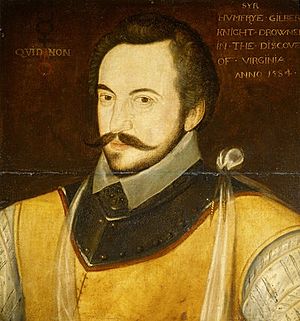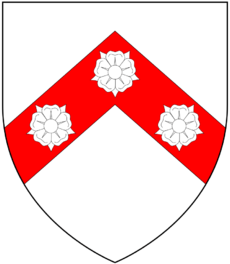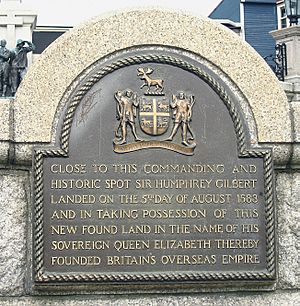Humphrey Gilbert facts for kids
Quick facts for kids
Sir Humphrey Gilbert
|
|
|---|---|

Portrait at Compton Castle
|
|
| Born | c. 1539 Greenway, Brixham, England
|
| Died | 9 September 1583 (aged 43–44) waters off the Azores
|
| Education | Eton College |
| Alma mater | University of Oxford |
| Spouse(s) | Anne Aucher (1548-1631) m 1570 |
| Children | 6 sons and 1 daughter |
| Parent(s) |
|
| Signature | |
 |
|
Sir Humphrey Gilbert (around 1539 – 9 September 1583) was an English adventurer, explorer, and soldier. He also served as a Member of Parliament. He was important in starting England's colonies in North America and in Ireland. He was the half-brother of Sir Walter Raleigh.
Contents
Biography
Early life and education
Humphrey Gilbert was born around 1539 in Devon, England. His parents were Otho Gilbert and Catherine Champernowne. He had brothers, Sir John and Adrian. His half-brothers were Carew Raleigh and Sir Walter Raleigh. His aunt, Kat Ashley, worked for Queen Elizabeth I. She helped Humphrey and his relatives get involved at court. His uncle, Sir Arthur Champernowne, also helped him with projects in Ireland.
Gilbert went to Eton College and the University of Oxford. There, he learned French and Spanish. He also studied war and how to navigate ships. Later, he lived in London.
In 1563, he was wounded while fighting in France. By 1566, he was serving in Ireland. He worked under Sir Henry Sidney, who was the Lord Deputy of Ireland. Later that year, he sent a report to the Queen. He also gave her his ideas for finding a new way to China. This idea was about a Northwest Passage through America.
Military service in Ireland
After a leader named O'Neill was killed in 1567, Gilbert became governor of Ulster, a province in Ireland. He also became a member of the Parliament of Ireland. He asked to return to England because of his eyes. However, he still wanted to work in Ireland, especially in the southern province of Munster.
In 1569, he suggested setting up a government for Munster. He also wanted to create a large English settlement near Baltimore. This plan was approved. On January 1, 1570, Sir Henry Sidney made Gilbert a knight for his service.
Gilbert was involved in conflicts in southern Ireland. These events led to the Desmond Rebellions. He fought against Irish leaders who resisted English control. In 1569, he was promoted to colonel. He led his forces through County Kerry and Connello. During this time, his forces captured many castles.
Member of Parliament and explorer
In 1570, Gilbert returned to England. He married Anne Ager, and they had six sons and one daughter. In 1571, he became a Member of Parliament for Plymouth. In 1572, he became an MP for Queenborough. He supported the Queen's power in certain matters.
Gilbert also became interested in exploration. He believed in finding a Northwest Passage to Cathay (China). He argued that this route would be safer than a Northeast Passage. He said the northern route was too foggy and dangerous. He thought England needed to explore new lands to compete with Spain and Portugal.
In 1578, Gilbert received permission from the Queen to explore. He sailed from Plymouth with seven ships. However, storms scattered his fleet. Most of his ships had to return to port. Only one ship, the Falcon, commanded by Walter Raleigh, went far into the Atlantic.
In 1579, Gilbert was asked to attack Irish rebels again. He had three ships: the Anne Ager, the Relief, and the small Squirrell. His voyage was difficult. He got lost in fog and storms. He also had conflicts with local people in Ireland.
Newfoundland and death
In 1583, Gilbert's license to explore was about to expire. He managed to get money from English Catholic investors. These investors hoped to settle in America. Gilbert planned to claim a large area of land in America for the English Crown.
Gilbert set sail with five ships in June 1583. One ship, the Bark Raleigh, turned back due to lack of supplies. Gilbert's crews were difficult to manage. Despite these problems, the fleet reached Newfoundland.
On August 5, 1583, Gilbert claimed Newfoundland for the English Crown. This act was a formal way of taking possession of the land. He claimed authority over the fishing stations there. He also charged a tax on fishermen from other countries.
However, his fleet soon left Newfoundland. They did not try to build a settlement because they lacked supplies. During the return trip, Gilbert sailed on the small ship Squirrell. He made a controversial decision to change course. As a result, the ship Delight ran aground and sank. Most of its crew were lost. This ship was the largest remaining and carried most of their supplies.
On September 9, 1583, the Squirrell faced high waves during a storm. Gilbert refused to move to the larger ship, Golden Hind. He was seen sitting in the back of his ship, reading a book. As the Golden Hind came close, Gilbert was heard shouting, "We are as near to Heaven by sea as by land!" He lifted his hand to the sky. At midnight, the Squirrell's lights went out. The ship sank with everyone on board. It is believed Gilbert was reading Sir Thomas More's book, Utopia.
Legacy
Sir Humphrey Gilbert was part of an important group of men from Devon. They were adventurers, writers, soldiers, and sailors.
He was known for his new ideas, even if he didn't always succeed. His biggest impact was in colonization. His efforts led to English settlements in Ireland. His formal claim of Newfoundland eventually became a reality in 1610. More importantly, his work helped Sir Walter Raleigh get a royal charter in 1584. This led to the Roanoke expeditions, which were the first serious attempts by England to create colonies in North America.
Gilbert's son, Ralegh Gilbert, later became second in command of the Popham Colony in Maine. A place near Greenland, Gilbert Sound, was named after him by John Davis.
Images for kids
See also
 In Spanish: Humphrey Gilbert para niños
In Spanish: Humphrey Gilbert para niños





